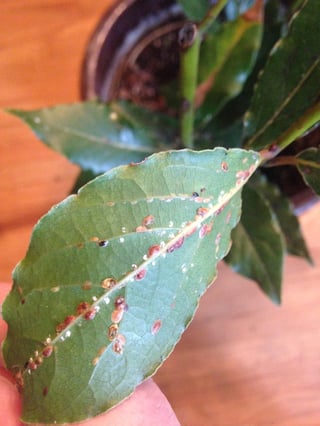I brought in my bay laurel (aka sweet bay, laurus nobilis) to clean it, and noticed an infestation of tiny "bug sacks" underneath the leaves, along the veins. What are they? I don't see any actual insects crawling around, (with my bare eyes).
I can get them off the leaf easily by exerting a tiny amount of pressure with a wiping rag. Is there a household product I can use, such as acetic acid, or some concoction of tea tree oil, that would remove them? I wish for them to magically fall off and disappear.
Climate: This plant lives in Vancouver, BC (wikipedia: Climate of Vancouver). It is not hot during the day, and it could not be any rainier. The pot sits on the north side of the building. Sits rarely in direct sunlight, since it is cloudy all the time and a nearby large conifer casts shadows. It stands on a covered patio most of the time




